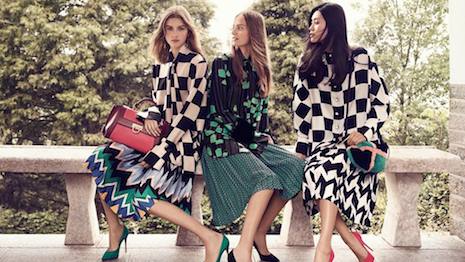- About
- Subscribe Now
- New York,
February 19, 2019

 Sales of clothing account for more than 40 percent of the Italy's fashion revenues. Image credit:Ferragamo
Sales of clothing account for more than 40 percent of the Italy's fashion revenues. Image credit:Ferragamo
Italy’s fashion sector is booming, but almost one-third of the country’s fashion sales are generated by brands owned by foreign shareholders.
Perhaps counterintuitively, a report from Mediobanca found that as fashion companies become more valuable for the Italian economy, non-domestic sales are of increasing importance. Europe’s largest fashion groups generated more than 85 percent of their 2017 sales outside of their respective countries of origin.
“The Italian fashion sector accounts for 1.3 percent of Italian GDP in 2017, compared with 1.1 percent in 2013,” said Nadia Portioli, analyst from Mediobanca Research Area, Milan. “Its power is based on the quality of ‘Made in Italy,’ which is universally known and loved.”
In addition to examining the largest European fashion groups, Mediobanca evaluated more than 160 Italian fashion companies with a turnover of more than 100 million euros, or $113 million at current exchange, in 2017.
Made in Italy
The Italian fashion industry had a growth rate of 4.5 percent in 2017, based on a survey of companies’ financial statements. This includes 26 Italian-based, French companies, of which 11 are owned by Kering and nine by LVMH, such as Fendi and Bottega Veneta.
Mediablanco assigned each fashion company a primary sector: clothing, leather goods and footwear, jewelry, textiles and eyewear.
Sales of clothing accounted for 40.5 percent of total revenue for Italian fashion companies in 2017. From 2013 to 2017, the jewelry sector had the highest rate of growth at 13.3 percent.
Tod's spring/summer 2019 campaign. Image credit: Tod's
Sixty-three percent of Italy’s fashion revenues originated abroad, up more than 22 percent from 2013’s non-domestic sales. In comparison, 56.7 percent of revenue for other Italian manufacturing companies comes from international markets.
Eyewear in particular thrives in markets outside of Italy, with non-domestic sales accounting for 89.8 percent the sector’s total. Textiles and leatherwear are also geared towards markets abroad.
Reflecting the sector’s rise, Italian fashion’s workforce has grown nearly 20 percent since 2013, totaling almost 363,000 employees in 2017.
Net profit as a percentage of sales also increased for Italian companies, hitting 5.3 percent in 2017. Mediobanca attributes this growth to a reduction in Italy’s tax rate.
In 2017, the country’s fashion sector recorded a profit of 3.8 billion euros, or about $4.29 billion at current exchange.
Bottega Veneta is one of several Italian brands owned by French luxury group Kering. Image credit: Bottega Veneta
Out of the 163 Italian fashion companies Medioblanca evaluated, 15 reported 2017 sales of more than 900 million euros, or $1.02 billion at current exchange.
Among the Italian luxury labels in the "Top 15" are Prada, Giorgio Armani, Salvatore Ferragamo, Dolce & Gabbana, Valentino, Moncler and Tod’s.
Luxury fashion growth
French luxury group Kering’s consolidated revenues were up 26.3 percent in 2018, as its key fashion houses saw double-digit increases.
Kering’s revenues for the year totaled 13.67 billion euros, or about $15.46 billion at current exchange. Italian fashion label Gucci’s growth was slightly down from 2017, but the brand still saw a revenue increase of 33.4 percent.
While all regions saw growth, Gucci’s increases were primarily driven by Asia-Pacific and North America (see story).
Together, Italy’s most valuable brands are worth 72.5 billion, or about $89.3 billion. About a third of this total comes from luxury companies.
Gucci tops BrandZ’s Italian-focused rankings with a value of around $16 billion. The almost 100-year-old label has seen an 8 percent growth in brand value over the last year.
Prada comes in at number five, while fashion labels Bottega Veneta, Salvatore Ferragamo and Fendi also make the list (see story).
“The Top 15 [Italian companies] can count on the strength of brands which symbolize the quality of ‘Made in Italy’ and on Italian creativity which is unique in the world,” Ms. Portioli said. “In order to take on the larger French leaders they have to continue to invest in new materials, new products and ideas, on innovation, technology and creativity.”
Share your thoughts. Click here